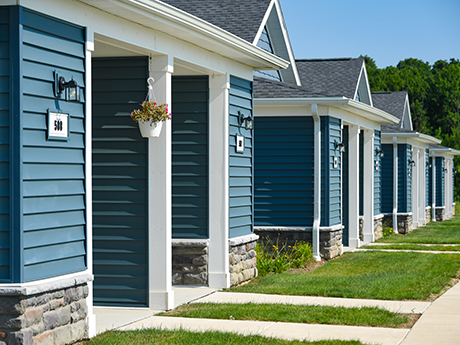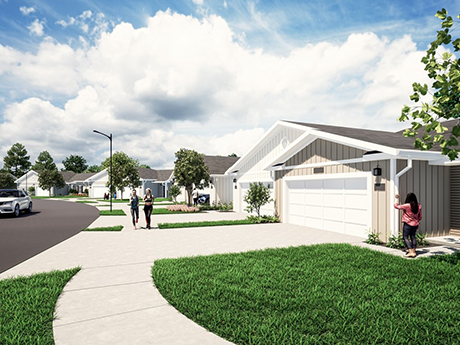By Kristin Harlow
Higher rents and lower turnover are a few of the key advantages build-to-rent (BTR) properties have over traditional multifamily product, according to investors. Meanwhile, the sector continues to experience strong demand from tenants priced out of the housing market as well as renters by choice who prefer flexible, maintenance-free living.
BTR units typically have all the perks of a single-family home — privacy, garages and yards — without the hassles of landscaping or property maintenance.
“The BTR sector is experiencing significant growth because it addresses a genuine need in today’s housing market,” says Khrista Villegas, managing director of Material Capital Partners (MCP), a Charleston, South Carolina-based development and investment firm focused on BTR communities in the Southeast and Midwest.
“Many prospective residents are moving away from traditional apartments, seeking the space, privacy and community feel of a single-family home without the commitment and burden of ownership. This trend is especially pronounced among millennials and Gen Z renters who value lifestyle flexibility, outdoor space and neighborhood connectivity — features that traditional apartments often lack,” explains Villegas. (Gen Z, the demographic cohort succeeding millennials, includes persons born between approximately 1997 and 2012.)
Many millennials and Gen Zers are postponing family formation, but they are growing tired of smaller spaces, loud neighbors, detached parking and common area hallways, says Josh Wohlreich, a principal with Arlington Heights, Illinois-based Heyday, a developer specializing in BTR communities.

“Many are burdened with debt, putting homeownership out of reach, while others simply do not believe in the traditional model of homeownership the way earlier generations have,” he says.
The inflation-adjusted median monthly cost for U.S. homeowners with a mortgage increased to $2,035 in 2024, up nearly 4 percent from $1,960 in 2023, according to the latest data from the U.S. Census Bureau.
In Columbus, Ohio, a three-bedroom home for sale with comparable features to a nearby BTR unit costs $4,221 per month to own versus $3,100 to rent, according to Walker & Dunlop in its 2025 BTR report.
Additionally, sources note a rising number of retirees who prefer to sell their homes and instead opt for the convenience of renting. According to Wohlreich, 10,000 baby boomers retire each day, making them the fastest-growing renter demographic whose needs and lifestyle are consistent with BTR living.
“Boomers are valuing a ‘lock-and-leave’ lifestyle where all home maintenance is taken care of by someone else,” says Wohlreich. “They are choosing to sell their homes and use home equity they have built up for travel and other lifestyle amenities.”
Widespread Appeal
The limited supply of housing for first-time homebuyers is also boosting the BTR segment.
“Entry-level housing simply does not exist,” states Wohlreich. “In the 1970s, homes 1,400 square feet and smaller comprised 35 to 40 percent of new single-family home deliveries. Today, that number is estimated between 7 to 10 percent.
“With builders focused on larger, more profitable home construction, first-time homebuyers do not have a high-quality, new-construction alternative,” continues Wohlreich.
In some ways, the BTR segment is helping to pave the way for the next generation of homebuyers.
“When baby boomers choose to sell to move into our product, their home is now available to the next generation to purchase, helping add for-sale product to the very supply-constrained inventory of affordable single-family homes,” says Wohlreich.

BTR communities can also serve as a stepping stone for those who aim to buy a home one day.
“It’s not news to anybody that it’s very costly to own a home,” says Anthony Tiritilli, president of development with Lynd Development Group, a division of The Lynd Group in San Antonio. “The down payment, additional costs of homeownership and current interest rates put ownership out of reach for a lot of people.
“I don’t think they’ve lost the desire to own a home, but there’s a big demographic that is starting a family and may not be in the position to afford a home. BTR serves as a way to get out of an apartment and into something that looks like single-family.”
Travis Gensley, vice president of investments with Cleveland-based Stark Enterprises, says that BTR currently makes up a very small segment of the overall multifamily market. “We expect BTR to remain a durable asset class so long as projects are well located, rightsized and priced for local incomes.”
Typical BTR Features
BTR homes usually feature patios, attached garages, driveways and fenced yards. The floor plans tend to be larger than traditional multifamily units with no residents above or below them. Sources emphasize the importance of parking. Tenants prefer two-car garages in addition to a driveway that can fit two vehicles.
“We try to design units that are as close to single-family as you can get,” says Tiritilli.
For Villegas, it’s important to create an authentic neighborhood feel and avoid a one-size-fits-all approach. “Each community is thoughtfully designed to reflect its unique location and character, with exterior and interior finishes carefully chosen to complement the surrounding environment,” she says.
At its Harmony at Clear Creek development in Shawnee, Kansas, MCP is implementing a modern interpretation of rustic design, according to Villegas. The 188-unit project will feature three- and four-bedroom homes ranging from 2,100 to 3,300 square feet. Construction recently began, and the first homes are expected to be available for rent by October 2026, with the entire community completed by February 2028.
Lynd currently has two projects that are exclusively BTR, one of which the developer just delivered in Oswego, Illinois. Named Home at Ashcroft, the development was 86 percent leased as of late October. The property features three-bedroom homes averaging 1,775 square feet. Monthly rents range from $2,800 to $4,000, and 12- to 18-month lease terms are available.
“BTR does tend to be more expensive on a gross rent basis than multifamily, so you need to make sure that the demographic is there for the financial criteria you’re seeking to get in rent,” says Tiritilli. “From an operator perspective, BTR lease terms tend to be longer, and renewals tend to be greater than traditional multifamily. That’s a big advantage.”
On average, BTR rents are 20 to 25 percent higher than conventional multifamily communities, according to Berkadia, which has been active in the BTR space since 2012. The product type also has lower turnover costs due to the “stickier” tenant base. Apartment turnover costs are nearly $4,000 per unit, according to property management automation company Zego.
Earlier this year, Heyday completed Heyday Oak Creek, a 130-unit community in Oak Creek, Wisconsin. Homes come in one-, two- and three-bedroom floor plans.
“The site plan emphasizes a low-density, tranquil atmosphere complete with lamppost-lined streets, garden-style courtyards and connected walking and biking paths,” says Wohlreich. “Residents enjoy easy access to Drexel Town Square, the airport, major employers and downtown Milwaukee, along with modern conveniences such as online rent payments, digital maintenance requests and electric vehicle-ready garages.”
Homebuilder Onyx+East maintains a BTR portfolio in Indiana and Ohio. Most of the communities include three- and four-bedroom floor plans. In urban locations, the firm will build townhome-style residences with two- and three-bedroom units for rent.
Kelli Lawrence, CEO of Onyx+East, says that Marea in Noblesville, Indiana, is now approaching stabilization and is roughly 82 percent leased. May Square in Cincinnati is a townhome BTR community that is slated to begin leasing in the first quarter of 2026.
“We evaluate the cost of new construction relative to achievable rents and compare that with traditional multifamily performance,” says Lawrence. “We identify target markets with strong characteristics such as great schools, access to employment centers, abundant lifestyle amenities and positive population and job growth.”
Stark Enterprises is under construction on Teal Ridge Village in Gretna, Nebraska. Slated for delivery in the third quarter of 2027, the 244-unit community will feature a mix of one- to three-bedroom floor plans. Monthly rents will start around $1,800.
Gensley says each home will feature granite countertops, stainless steel appliances, 9-foot ceilings, covered front porches, private patios, walk-in closets and two-car attached garages with private driveways. Homes will also be outfitted with high-speed internet, cable access and in-unit washer and dryer systems.
Amenity Approach
Many of today’s BTR communities come with a wide array of amenities. Projects often feature clubhouses, fitness centers, coworking spaces, pools, dog parks and walking trails.

“All of our new projects are highly amenitized,” says Tiritilli. “We promote wellness throughout our company, so we have a chief wellness officer that customizes and designs all of our fitness centers. We’ve added coworking to a lot of our clubhouses — open areas and conference rooms enable people to take meetings outside their homes.”
Lynd’s BTR communities also come with a robust technology package equipped with smart locks and smart thermostats. This feature appeals to empty nesters or snowbirds that may be away for long periods at a time.
“If residents are away, smart tech enables them to have deliveries made,” says Tiritilli. “We’ll even do indoor plant watering. It’s an amenity-rich and maintenance-free environment.”
In contrast, Heyday communities do not offer traditional amenities like pools or fitness centers.
“These types of communal amenities are not the expectation in the single-family home space,” says Wohlreich. “Instead, we invest in the actual home, with higher-end finishes, larger kitchens, bedrooms and bathrooms, more storage, dedicated work-from-home spaces and private two-car garages with high-speed electric charging in each garage. We believe in trading traditional amenities for a better living experience inside the home and the community at large.”
Desirable Fundamentals
BTR supply remains limited in the Midwest compared with faster-growing regions like the Sunbelt. Roughly 63,775 BTR units were under construction across the U.S. as of September, according to RealPage Market Analytics. Of that total, 6,400 units were in the Midwest.
In October, the Midwest led year-over-year rent growth for single-family rentals, accounting for seven of the top nine metros, according to Yardi Matrix.
“The Midwest is an emerging market for BTR communities, with many of the first large-scale developments now leasing up,” says Lawrence. “Demand has been exceptionally strong, and we foresee tremendous growth in the Midwest as we move into 2026.”
“The balance of strong demand and moderate new supply has kept occupancy rates high and rent growth steady,” echoes Villegas. “The Midwest’s steady job growth, affordability and available land make it a great region for the BTR model, and we expect that demand to remain healthy for the foreseeable future.”
Occupancy at MCP’s properties has typically remained in the mid to upper 90 percent range, according to Villegas. MCP focuses on markets with strong population and job growth, high-performing schools and convenient access to major employment centers, shopping and recreation. “Those fundamentals help ensure long-term demand and community stability,” says Villegas.
According to Wohlreich, Heyday’s current portfolio is 98 percent occupied. “With the demographic, lifestyle and supply factors, the demand for the product is nationwide and systemic,” he says.
When selecting a market for a new project, Heyday focuses on areas that are underserved by the BTR product type but also have the incomes necessary to support the absorption of around 150 homes. It’s also critical to identify municipalities that understand and support BTR housing, as well as sites that are near municipal utility services and other amenities, according to Wohlreich.
Many Midwest markets tend to be supply constrained with high barriers to entry, factors that Tiritilli finds desirable. “The more difficult it is to enter a market, the more comfortable we feel to be in that market for the long term,” he says. “BTR is an asset class we are promoting just as much as we would multifamily. That’s how much we believe in it.”
This article was first published in sister publication Heartland Real Estate Business.


